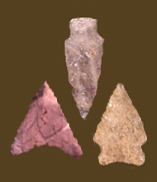
|
BREWERTON EARED TRIANGLE Defining Attributes Chronology Description Haft Element: The base of this stemless point is usually slightly concave, but is sometimes straight. It can be ground. Small, delicate ears are present on either side of the broad base. Size: Length ranges from 22 to 66 mm, with most between 27 and 38 mm. Width ranges from 16 to 26 mm, with an average of 20 mm. Thickness ranges from 4 to 6 mm, with an average of 5 mm. Technique of manufacture: Carefully made by pressure flaking. Material: In a sample of 14 Brewerton Eared Triangle points from the lower Patuxent drainage, Steponaitis (1980) reported that 70% were quartz, followed by rhyolite (23%) and quartzite (7%). In the area surrounding Zekiah Swamp on the lower Potomac, Wanser (1982) found that 69% of 13 Brewerton Eared Triangle points were quartz, with 15% rhyolite, 8% quartzite, and 8% chert. Discussion Ritchie (1971) notes that these points intergrade with the Brewerton Eared Notched point, and may have developed from that type. Justice (1987) considers the Brewerton Eared Triangle to be a variant of the Brewerton Eared Notched, with the Eared Triangle generally wider and thinner than Eared Notched points of the same length, which may be a reflection of the amount of re-sharpening on examples of the two types. Defined in Literature References Custer 1996b; Funk 1993; Justice 1987; Ritchie 1971; Steponaitis 1980; Wanser 1982 |
![]()
Search by Shape:
(See Projectile Point Typology) |

|
Thank you for visiting our website. If you have any
questions, comments, Copyright © 2002 by |

|

